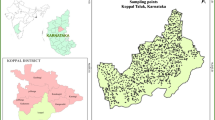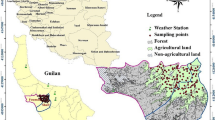Abstract
Soil provides crop with nutrients, water and root support. But, soils vary a great deal in terms of origin, appearance, characteristics and production capacity. Better understanding of the causality between yield and yield-limiting soil factor(s) is essential for site-specific crop management. The objectives of this study were deriving a spatiotemporal yield trend map of a 144 km2 paddy rice growing region located at an alluvial plain in southwestern Taiwan from satellite images and exploring the potential yield-limiting soil factor(s) in conjunction with general soil survey data. Due to the complexity of data sets, classification and regression trees analysis (CART) was used to relate soil characteristics to yield classes in the spatiotemporal yield trend map, and followed by comparisons of soil characteristics between those consistently-high and -low yielding areas to explore the interactions between yields and soil properties. Through the above data mining analysis, high soil pH, severe leaching loss of applied nitrogen fertilizers, and excessive reductive root environment were suspected to be the major soil related low-yielding mechanisms spread within studied region. Soil characteristics that induced these low-yielding mechanisms were identified and mapped. Error analysis indicated that 61.8 % of the consistently low-yield areas could be correctly identified by just a few soil characteristics. Improvements of management practices to alleviate the negative effects on yields were also proposed based on the identified low yielding mechanisms. Our study highlighted the pressing need and possible methodologies to adjust management strategies for narrowing yield variability and increasing crop production.




Similar content being viewed by others
Abbreviations
- CART:
-
Classification and regression tree analysis
- CV:
-
Coefficient of variation
- H:
-
Consistent-high yield class
- ID:
-
Internal drainage grade
- L:
-
Consistent-low yield class
- M:
-
Consistent-average yield class
- N:
-
Nitrogen
- SD:
-
Standard deviation
- SPOT:
-
Satellite Pour l’Observation de la Terre
- SY:
-
Standardized yield
- T1–T4:
-
Soil texture grade at four layers
- V:
-
Inconsistent yield class
References
Abolfazli, F., Forghani, A., & Norouzi, M. (2012). Effects of phosphorus and organic fertilizers on phosphorus fractions in submerged soil. Journal of Soil Science and Plant Nutrition, 12, 349–362.
Alloway, B. J. (2009). Soil factors associated with zinc deficiency in crops and humans. Environmental Geochemistry and Health, 31, 537–548.
Armstrong, W., & Drew, M. C. (2002). Root growth and metabolism under oxygen deficiency. In Y. Waisel, A. Eshel, & U. Kafkafi (Eds.), PLANT Roots: THE HIDDEN HALF (3rd ed., pp. 729–761). New York: Marcel Dekker.
Breiman, L, Friedman, J., Olshen. R., & Stone, C. (1984). Classification and regression trees (54 pp.). New York, NY: Chapman and Hall (Wadsworth, Inc.).
Brevik, E. C., Fenton, T. E., & Jaynes, D. B. (2003). Evaluation of the accuracy of a central Iowa soil survey and implications for precision soil management. Precision Agriculture, 4, 331–342.
Chiou, C. R., Liang, Y. C., Lai, Y. J., & Huang, M. Y. (2004). A study of delineation and application of the climatic zones in Taiwan. Journal of Taiwan Geographic Information Science, 1, 41–62.
Choudhury, A. T. M. A., & Kennedy, I. R. (2005). Nitrogen fertilizer losses from rice soils and control of environmental pollution problems. Communications in Soil Science and Plant Analysis, 36, 1625–1639.
De Datta, S. K. (1981). Principles and practices of rice production. New York: Wiley.
De Datta, S. K., & Mikkelsen, D. S. (1985). Potassium nutrition of rice. In R. D. Munson (Ed.), Potassium in agriculture (pp. 665–699). Madison, Wisconsin USA: ASA, CSSA, SSSA.
Dobermann, A., Ping, J. L., Adamchuk, V. I., Simbahan, G. C., & Ferguson, R. B. (2003). Classification of crop yield variability in irrigated production fields. Agronomy Journal, 95, 1105–1120.
Franzen, D. W., Hopkins, D. H., Sweeney, M. D., Ulmer, M. K., & Halvorson, A. D. (2002). Evaluation of soil survey scale for zone development of site-specific nitrogen management. Agronomy Journal, 94, 381–389.
Gallego, J., Carfagna, E., & Baruth, B. (2010). Accuracy, objectivity and efficiency of remote sensing for agricultural statistics. Agricultural survey methods (pp. 193–211). West Sussex, UK: Wiley.
Guo, H. Y., Liu, T. S., Chu, C. L., & Chiang, C. F. (2009). Development of soil information system and its application in Taiwan. In: Proceedings of Monsoon Asia Agro-Environmental Research Consortium: A new approach to soil information systems for natural resources management in Asian countries. October 13–17, 2008, Tsukuba, Japan.
Hochman, Z., Gobbett, D., Holzworth, D., McClelland, T., Van Rees, H., Marinoni, O., et al. (2012). Quantifying yield gaps in rainfed cropping systems: A case study of wheat in Australia. Field Crops Research, 136, 85–96.
Hsieh, S. C., & Liu, D. J. (Eds.). (1979). The causes of low yield of the second crop rice in Taiwan and the measures for improvement. In: Proceedings of a symposium held at Taiwan Agricultural Research Institute, June 7–8, 1978. Taiwan, ROC: National Science Council. (In Chinese with English abstract).
Kropff, M. J., Cassman, K. G., van Laar, H. H., & Peng, S. (1993). Nitrogen and yield potential of irrigated rice. Plant and Soil, 155(156), 391–394.
Kumari, A., Kapoor, K. K., Kundu, B. S., & Mehta, R. K. (2008). Identification of organic acids produced during rice straw decomposition and their role in rock phosphate solubilization. Plant, Soil and Environment, 54, 72–77.
Lobell, D. B. (2013). The use of satellite data for crop yield gap analysis. Field Crops Research, 143, 56–64.
Lobell, D. B., Cassman, K. G., & Field, C. B. (2009). Crop yield gaps: Their importance, magnitudes, and causes. Annual Review of Environment and Resources, 34, 179–204.
Lobell, D. B., Ortiz-Monasterio, J. I., & Falcon, W. P. (2007). Yield uncertainty at the field scale evaluated with multi-year satellite data. Agricultural Systems, 92, 76–90.
Mikkelsen, D. S., De Datta, S. K., & Obcemea, W. N. (1978). Ammonia volatilization losses from flooded rice soils. Soil Science Society of America Journal, 42, 725–730.
Minamikawa, K., & Sakai, N. (2006). The practical use of water management based on soil redox potential for decreasing methane emission from a paddy field in Japan. Agriculture, Ecosystems & Environment, 116, 181–188.
Moulin, S., Bondeau, A., & Delecolle, R. (1998). Combining agricultural crop models and satellite observations: From field to regional scales. International Journal of Remote Sensing, 19, 1021–1036.
Ponnamperuma, F. N. (1972). The chemistry of submerged soils. Advances in Agronomy, 24, 29–96.
Ponnamperuma, F. N. (1976). Specific soil chemical characteristics for rice production in Asia. In International Rice Research Institute Res. Paper Ser. 2. Manila, Philippines.
Saleque, M. A., Naher, U. A., Islam, A., Pathan, A. B. M. B. U., Hossain, A. T. M. S., & Meisner, C. A. (2004). Inorganic and organic phosphorus fertilizer effects on the phosphorus fractionation in wetland rice soils. Soil Science Society of America Journal, 68, 1635–1644.
Sharma, P. K., & De Datta, S. K. (1986). Physical properties and processes of puddled rice soils. Advances in Soil Science, 5, 139–178.
Sheh, C. S. & Wang, M. K. (Eds.). (1989). Soils of Taiwan—explanatory text of the 1988 soil map of Taiwan. Soil Survey and Testing Center, National Chung Hising University. (In Chinese with English abstract).
Shen, J. B., Yuan, L. X., Zhang, J. L., Li, H. G., Bai, Z. H., Chen, X. P., et al. (2011). Phosphorus dynamics: From soil to plant. Plant Physiology, 156, 997–1005.
Soil Survey Division Staff. (1993). Soil survey manual. Soil Conservation Service. U.S. Department of Agriculture Handbook 18.
Sun, T. L., & Yang, T. C. (1989). The occurrence of poor drainage conditions in alluvial soils of Taiwan. Journal of the Chinese Agricultural Chemical Society, 27, 38–45. (In Chinese with English abstract).
Tittonell, P., Shepherd, K. D., Vanlauwe, B., & Giller, K. E. (2008). Unravelling the effects of soil and crop management on maize productivity in smallholder agricultural systems of western Kenya—An application of classification and regression tree analysis. Agriculture, Ecosystems & Environment, 123, 137–150.
Towprayoon, S., Smakgahn, K., & Poonkaew, S. (2005). Mitigation of methane and nitrous oxide emissions from drained irrigated rice fields. Chemosphere, 59, 1547–1556.
Van Ittersum, M. K., Cassman, K. G., Grassini, P., Wolf, J., Tittonell, P., & Hochman, Z. (2013). Yield gap analysis with local to global relevance—a review. Field Crops Research, 143, 4–17.
Van Ittersum, M. K., & Rabbinge, R. (1997). Concepts in production ecology for analysis and quantification of agricultural input-output combinations. Field Crops Research, 52, 197–208.
Vlek, P. L. G., & Craswell, E. T. (1979). Effect of nitrogen source and management on ammonia volatilization losses from flooded rice-soil systems. Soil Science Society of America Journal, 43, 352–358.
Wang, Y. P., Chang, K. W., Chen, R. K., Lo, J. C., & Shen, Y. (2010). Large area rice yield forecasting using satellite imageries. International Journal of Applied Earth Observation and Geoinformation, 12, 27–35.
Wang, Y. P., Chen, S. H., Chang, K. W., & Shen, Y. (2012). Identifying and characterizing yield limiting factors in paddy rice using remote sensing yield maps. Precision Agriculture, 13, 553–567.
Wissuwa, M., Ismail, A. M., & Yanagihara, S. (2006). Effects of zinc deficiency on rice growth and genetic factors contributing to tolerance. Plant Physiology, 142, 731–741.
Wollenhaupt, N. C., Mulla, D. J., & Gotway Crawford, C. A. (1997). Soil sampling and interpolation techniques for mapping spatial variability of soil properties. In F. J. Pierce & E. J. Sadler (Eds.), The state of site specific management for agriculture (pp. 19–53). Madison, WI: ASA, CSSA, and SSSAJ.
Yang, S. H., Peng, S. H., Xu, J. Z., Hou, H. J., & Gao, X. L. (2013). Nitrogen loss from paddy field with different water and nitrogen managements in Taihu lake region of China. Communications in Soil Science and Plant Analysis. doi:10.1080/00103624.2013.803564.
Yoshida, S. (1981). Fundamentals of rice crop science. Los Baños, Philippines: IRRI.
Zwart, S. J., & Leclert, L. M. C. (2010). A remote sensing-based irrigation performance assessment: A case study of the Office du Niger in Mali. Irrigation Science, 28, 371–385.
Acknowledgments
This work was supported by Grants (NSC-99-2313-B-005-022-MY3, NSC-102-2313-B-005-018) from National Science Council, Taiwan, ROC.
Author information
Authors and Affiliations
Corresponding author
Rights and permissions
About this article
Cite this article
Wang, YP., Shen, Y. Identifying and characterizing yield limiting soil factors with the aid of remote sensing and data mining techniques. Precision Agric 16, 99–118 (2015). https://doi.org/10.1007/s11119-014-9365-6
Published:
Issue Date:
DOI: https://doi.org/10.1007/s11119-014-9365-6




